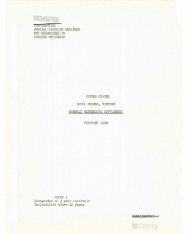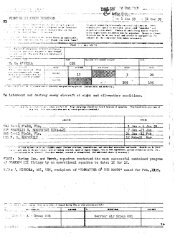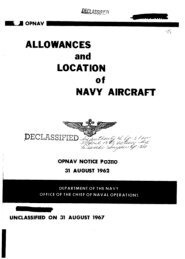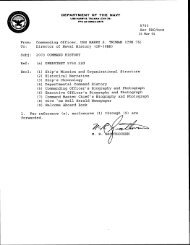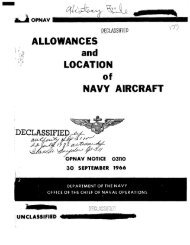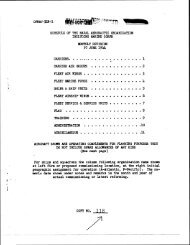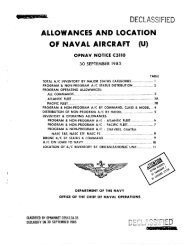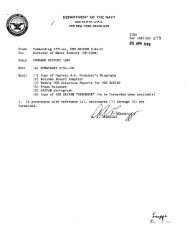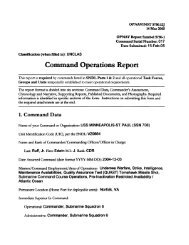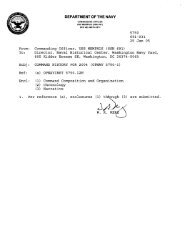The harrier - Naval History and Heritage Command
The harrier - Naval History and Heritage Command
The harrier - Naval History and Heritage Command
Create successful ePaper yourself
Turn your PDF publications into a flip-book with our unique Google optimized e-Paper software.
<strong>The</strong> Corps Goes Vertical with<br />
<strong>The</strong> Harrier<br />
By Ben Kristy<br />
An AV-8B Harrier II with the VMA-513 Nightmares l<strong>and</strong>s aboard USS Essex (LHD 2). <strong>The</strong> Harrier celebrates 40 years of<br />
service in 2011. <strong>The</strong> Nightmares were the first squadron to receive the aircraft in 1971. (Photo by MC3 Gabriel S. Weber)<br />
24 1911 2011<br />
<strong>Naval</strong> Aviation News
January 2011 marked the 40 th anniversary of vertical/<br />
short take-off <strong>and</strong> l<strong>and</strong>ing (V/STOL) tactical aviation in<br />
the United States—four decades since the Marine Corps<br />
received its first AV-8A Harriers <strong>and</strong> inaugurated a new<br />
age of U.S. <strong>Naval</strong> Aviation. Today, the AV-8B Harrier II<br />
remains one of Marine Corps aviation’s primary weapons<br />
<strong>and</strong> the only V/STOL attack aircraft ever fielded by the<br />
U.S. military. As the Corps awaits the arrival of its third<br />
generation V/STOL aircraft—the F-35B Lighting II—the<br />
story of how this technology came to be such a crucial part<br />
of Marine aviation is all the more remarkable.<br />
Between 1946 <strong>and</strong> 1956, the Marine Corps reorganized to<br />
meet the challenges of amphibious warfare in the atomic<br />
age. World War II-style amphibious<br />
operations, which were supported<br />
by numerous ships anchored closely<br />
off shore, appeared to be no longer<br />
possible against a foe possessing<br />
atomic weapons. Amphibious l<strong>and</strong>ings<br />
would now depend on the Corps’<br />
ability to disembark troops from<br />
ships dispersed over the horizon from<br />
the targeted beachhead. <strong>The</strong> Marine<br />
Corps altered its divisional table of<br />
organization, making the force lighter<br />
<strong>and</strong> more easily transportable by sea,<br />
air, <strong>and</strong> l<strong>and</strong> by stripping away most<br />
of its heavy weapons. <strong>The</strong> helicopter,<br />
itself a new technology at the time,<br />
provided the means of delivering <strong>and</strong><br />
resupplying the initial wave of troops.<br />
<strong>The</strong> integrated use of Marine close air<br />
support would make up for the loss of<br />
organic firepower. Thus, the Marines<br />
needed a tactical attack aircraft that<br />
could be based as close to the front<br />
lines as possible. It was against this<br />
background that in 1957 Comm<strong>and</strong>ant of the Marine<br />
Corps Gen. R<strong>and</strong>olph McCall Pate committed the service<br />
to fielding a fleet of V/STOL aircraft. Unfortunately, there<br />
were no such aircraft available at that time. American<br />
aircraft manufacturers spent millions of dollars attempting<br />
to develop functioning V/STOL aircraft between 1946<br />
<strong>and</strong> the early 1960s, but no projects progressed beyond the<br />
technology demonstration stage.<br />
In the United Kingdom, however, Hawker Siddeley was<br />
working on a revolutionary aircraft that showed promise—<br />
the XV-6A Kestrel. <strong>The</strong> Kestrel was much closer to being<br />
an operational tactical aircraft than anything produced<br />
by the American aviation industry. <strong>The</strong> Army, Air Force,<br />
<strong>and</strong> Navy all expressed some initial interest in the Kestrel,<br />
which was extensively tested in the early 1960s in the<br />
Lt. Gen. Thomas Miller Jr. retired from<br />
the Marine Corps in 1979 after nearly four<br />
decades of service. He passed away in 2007.<br />
Miller’s determined effort to acquire <strong>and</strong> field<br />
a tactical V/STOL fighter for the Marine Corps<br />
remains his greatest legacy.<br />
(Photo from National Marine Corps Museum)<br />
United States. Interest in the XV-6A waned, however,<br />
following the flight tests primarily because the aircraft was<br />
limited to subsonic speeds.<br />
In 1966, Gen. Keith McCutcheon, the Corps’ leading<br />
expert on close air support, served as the Deputy Chief<br />
of Staff, Air. McCutcheon had developed the close air<br />
support tactics <strong>and</strong> procedures that allowed Marine<br />
aviation to support Gen. Douglas MacArthur’s forces in<br />
the Philippines during World War II. He later became<br />
an early helicopter advocate, helping to craft the vertical<br />
assault doctrine while comm<strong>and</strong>ing both HMX-1, the<br />
Corps’ first helicopter squadron, <strong>and</strong> HMR-161 during the<br />
Korean War. Working for McCutcheon was Col. Thomas<br />
Miller Jr., who had his own formidable<br />
list of credentials including combat<br />
missions in World War II, Korea,<br />
<strong>and</strong> Vietnam. Miller headed the Air<br />
Weapons Requirement Branch <strong>and</strong><br />
was responsible for finding aircraft<br />
suitable for Marine Corps operations.<br />
Miller was not impressed with the<br />
Royal Air Force’s new GR MK-1<br />
Harrier—the operational aircraft<br />
developed from the Kestrel—because<br />
its 19,500-lb.-thrust Pegasus MK-<br />
101 engine did not offer the Marine<br />
Corps enough of a performance<br />
advantage over the Douglas A-4<br />
Skyhawks already in service. Miller’s<br />
interest in the aircraft increased,<br />
however, after learning that the next<br />
generation Pegasus engine offered<br />
2,000 additional pounds of thrust—all<br />
of which could be converted directly<br />
into carrying more ordnance.<br />
Miller worked with Hawker Siddeley<br />
to arrange for a series of flight tests in Engl<strong>and</strong>, but did so<br />
carefully to avoid upsetting <strong>Naval</strong> Air Systems Comm<strong>and</strong><br />
(NAVAIR) <strong>and</strong> Congress, <strong>and</strong> used his attendance at the<br />
1968 Farnborough Air Show as a cover story. Miller, Lt.<br />
Col. Clarence ‘Bud’ Baker, <strong>and</strong> Brig. Gen. W.G. Johnson<br />
visited Farnborough in civilian clothes so as not to arouse<br />
suspicion from the ever-present trade press. After the close<br />
of the air show, Miller <strong>and</strong> Baker completed 20 flights in<br />
the Harrier.<br />
<strong>The</strong>y were delighted with the aircraft, <strong>and</strong> told McCutcheon<br />
that the Harrier was the V/STOL aircraft the Marines had<br />
long desired. After Miller <strong>and</strong> McCutcheon briefed <strong>and</strong><br />
received approval from Chapman, McCutcheon created<br />
a small team comprised of himself, Miller, Baker, <strong>and</strong> Ed<br />
Harper (the program manager for the A-4) to begin the<br />
Summer 2011<br />
1911 2011 25
process of formulating a change to the Corps’ FY1970<br />
budget request for the purchase of an initial batch of 12<br />
Harriers. <strong>The</strong> challenge was to convince NAVAIR, the<br />
Pentagon, <strong>and</strong> Congress to purchase an unproven firstgeneration<br />
revolutionary aircraft, of foreign design, that was<br />
undesired by the Navy.<br />
McCutcheon <strong>and</strong> Miller’s team initiated a period of<br />
public <strong>and</strong> private briefings to justify the Corps’ purchase<br />
of the Harrier. Miller gained the support of the aircraft<br />
procurement sub-section of the President’s advisory<br />
committee. Other committee members helped to deflect<br />
opposition to the Harrier in various quarters of the Defense<br />
Department. <strong>The</strong> Navy agreed, somewhat reluctantly, to<br />
support the purchase on the condition that the Marine<br />
Corps would not ask for additional funding to pay for the<br />
aircraft. <strong>The</strong> Corps canceled the purchase of 17 McDonnell<br />
Douglas F-4Js to free up the required $57.6 million for the<br />
first production batch of Harriers.<br />
Miller <strong>and</strong> Baker gained the support of the major American<br />
aircraft manufacturers with the promise that after the<br />
initial batch of British-produced aircraft the rest of the<br />
Marine Harriers would be produced under license in the<br />
United States. Miller used his relationship with the head of<br />
McDonnell Douglas, S<strong>and</strong>y McDonnell, <strong>and</strong> the founder<br />
of the company, James McDonnell, to convince the aviation<br />
industry giant that the Harrier was good for both the Marine<br />
Corps <strong>and</strong> the American aviation industry. Congressional<br />
hearings on the Corps’ acquisition of the Harrier began in<br />
March 1969, leading to the purchase of the initial batch<br />
of 12 AV-8A Harriers. <strong>The</strong> remaining aircraft would be<br />
manufactured in the United States.<br />
Hawker Siddeley selected McDonnell Douglas, which<br />
was completing production on the similarly sized A-4<br />
Skyhawk, as its future production partner. <strong>The</strong> estimated<br />
costs of establishing a Harrier assembly line in America<br />
were prohibitive, however, <strong>and</strong> would have added at least<br />
an additional year to the procurement schedule. Congress<br />
dropped the requirement for the Harrier to be produced<br />
domestically; the entire production run of 110 AV-8As <strong>and</strong><br />
their engines were produced in the United Kingdom. After<br />
hearings in fall 1971 on the relative merits of the Army, Air<br />
In the winter of 1976-1977, 14 VMA-231 AV-8As deployed<br />
aboard USS Franklin D. Roosevelt (CV 42) to test the<br />
ability of a V/STOL aircraft to operate as part of a full<br />
carrier air wing. <strong>The</strong> tests showed the Harrier was fully<br />
capable of operating alongside non-V/STOL aircraft.<br />
(Photo from National Marine Corps Museum)<br />
26<br />
1911 2011 <strong>Naval</strong> Aviation News
An AV-8A with VMA-542 taxis from onto Lyman Road, Camp Lejeune, during exercises in 1978. <strong>The</strong> ability to operate from such<br />
austere locations was the main reason why the Marine Corps acquired the Harrier. (Photo from National Marine Corps Museum)<br />
Force, <strong>and</strong> Marine methodology of conducting close air<br />
support, the Senate Armed Services Committee threatened<br />
to cut off funding for the Harrier program at 60 aircraft. Once<br />
again, Marine political prowess paid off <strong>and</strong> full funding for<br />
the entire AV-8A fleet was secured in the FY1973 budget.<br />
<strong>The</strong> first AV-8As were officially accepted by the Marine Corps<br />
in January 1971, with VMA-513 beginning flight operations<br />
that April. Operational tests at Camp Lejeune <strong>and</strong> aboard<br />
USS Guam (LPH 9) demonstrated the AV-8A performed<br />
as expected. By the late 1970s, three attack squadrons <strong>and</strong> a<br />
training squadron were operating the AV-8A <strong>and</strong> TAV-8A.<br />
Efforts to develop a follow-on supersonic V/STOL aircraft,<br />
the AV-16, were stopped in the face of massive costs associated<br />
with development of the required engine. In 1975, however,<br />
the Chief of <strong>Naval</strong> Operations executive board approved a<br />
plan to use existing funds to explore future improvements to<br />
the AV-8A airframe proposed by McDonnell Douglas, thus<br />
beginning the development of the AV-8B Harrier II. Miller,<br />
now a general <strong>and</strong> the Marine Corps’ Deputy Chief of Staff<br />
for Aviation, spearheaded the effort to acquire funding for<br />
the new aircraft. Through his exertions, the more advanced<br />
American-produced Boeing AV-8B entered service in 1985.<br />
<strong>The</strong> first Marine Corps V/STOL combat air strike occurred<br />
on 17 January 1991 when a flight of VMA-311 AV-8Bs<br />
destroyed an Iraqi artillery battery near the Saudi Arabian<br />
town of Khafji. Subsequent operations flown by the enhanced<br />
AV-8B Plus <strong>and</strong> Night Attack variants in the Balkans,<br />
Iraq, <strong>and</strong> Afghanistan further demonstrated the combat<br />
capabilities of the Harrier II. In March 2011, AV-8Bs with<br />
the 26 th MEU were among the first aircraft to attack ground<br />
targets in Libya at the beginning of Operation Odyssey<br />
Dawn. Writing after his retirement from the Marine Corps<br />
in 1979, Miller, the first Marine to fly the Harrier, described<br />
the value of V/STOL aviation for the Marine Corps: “This<br />
improvement would be the saving of many Marines’ lives<br />
while in combat <strong>and</strong> would add significantly to the probability<br />
of their success in battle.” As the Marine Corps marks four<br />
decades of V/STOL operations, the Harrier continues to live<br />
up to Miller’s expectations.<br />
Ben Kristy is the aviation curator at the National Museum of the<br />
Marine Corps in Quantico, Va.<br />
Summer 2011<br />
1911 2011 27



